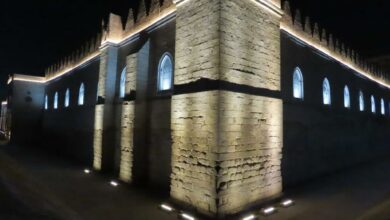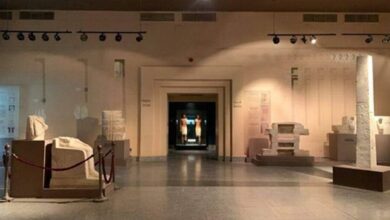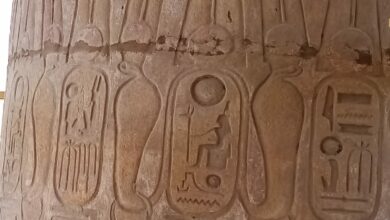Al-Masry Al-Youm speaks to Soheir Hawas, the head of the Studies Administration at the National Organization for Urban Harmony, about the rejuvenation of Downtown Cairo through a series of new regulations and pilot projects.
Al-Masry Al-Youm: Can you walk us through the parameters of Khedival Cairo that your work covers?
Soheir Hawas: Khedival Cairo is traditionally traced from Tahrir Square to Abdel Moneim Ryad Square, then off to Galaa Street and Ramses Square, to Claude Beh Street and Geish Street, leading to Abbassiya Square. Then we turn to part of Mohamed Ali Street, Hassan el-Akbar Street, Game’a Street and Nassereya Street, until we reach the ministries’ square. We then go to Qasr el-Aini Street and Sheikh Rihan Street and that would be the whole area.
Al-Masry: And this is designated as a protected area?
Hawas: This area has been designated as a protected area. It contains a few monumental buildings such as the Kekhya Mosque and the Egyptian National Museum. But more importantly, there are heritage buildings whose maintenance is governed by Law 144/2006. Those are buildings that are architecturally or historically significant–because they belong to an important period or historical figure–or are valuable for tourism. Examples include the buildings of the Revolutionary Command Council, which controlled Egypt during the early years of the 1952 revolution, or the house of legendary Egyptian singer Um Kalthoum. Those buildings are listed as protected.
Al-Masry: How is the listing done and who does it?
Hawas: Each governorate has one or more permanent committees that list heritage buildings. In Cairo, there are four such committees. The committees have representatives from the ministries of housing and culture, the governorate as well as university professors in the fields of history, architectural engineering, construction engineering, arts, and archeology. They identify buildings and submit their names to the cabinet for approval. We have completed this process for Cairo and the listed buildings here are now protected by law.
Al-Masry: And what happens once a building is protected?
Hawas: The objective of listing buildings is to preserve them, prolong their age and restore their image and original design. Many violations are committed: advertisements hiding building facades, residents closing balconies and making them part of their apartments, stores expanding their exteriors to cover neighboring buildings. These are all considered infringements on the rights of the preserved building. Abroad, no matter how big a store is, it has to abide by the rules of urban harmony. We started correcting these violations in places like the Groppi tearoom in Talaat Harb Square and the Shawarbi building near the High Court. Those buildings now shine. We brought special restoration stones and fixed the ornaments. We also removed the advertisements.
Al-Masry: The Ismailia Consortium for Real Estate Investment is acquiring many buildings in Khedival Cairo with plans for urban regeneration. Are you working together?
Hawas: We follow the work of the consortium step by step. They have to abide by the same rules for reuse, renovation or decoration. Our rules are clear and all concerned parties need to follow them. In general, I find the consortium and the Egyptian Insurance Company for Real Estate Properties, which owns 96 buildings downtown to be actively interested in restoring the area. We are in agreement and work in the same direction. For me, the question of ownership is irrelevant because I only work with the regulations I have, which are binding regardless of the owners.
Al-Masry: What else is needed for Downtown Cairo to be completely “restored”?
Hawas: Many things. I only work outdoors, not indoors. There are many issues pertaining to internal restoration that need attention. There is also the issue of financing. Restoration costs sometimes exceed the capacity of owners who collect very low rents. There are many proposals to solve this problem. For example, the government can provide loans which property owners then return in installments. Tenants need to chip into the process to feel responsible. Owners of listed buildings must feel privileged. They have to feel their building is special so they can understand how to protect it and derive a sense of pride from it.
Al-Masry: Do you have any requirements for service contractors involved in the implementation process?
Hawas: Any contractor needs to be registered with the National Organization for Urban Harmony. They need to have records of previous experience in the field of restoration since there are international regulations that inform restoration, renovation and reuse of valuable historical buildings. We have expertise in different fields that can be utilized in the implementation process, from landscape architecture, to restoration, to urban design.
Al-Masry: Are there any loopholes in your system that can give space to radical modifications in processes of urban regeneration?
Hawas: We don’t have this sort of consciousness to begin with. Unless someone has an intention to harm or destroy, I don’t see a real danger. For me, investing in urban regeneration and making money out of it while benefiting others is a positive thing. When capital is attracted to something, it means that this thing is promising. Money is a sensitive thermometer. When it goes somewhere, it knows that something positive is happening there. This indicates the success of our vision for Downtown. If an area has no potential, nobody will be interested in investing there.
Al-Masry: How are you engaging with other stakeholders in realizing your vision on the ground?
Hawas: We have a right to implement pioneering initiatives. We have a protocol of collaboration with the governorate of Cairo. Our first project is divided into three phases. It starts in Talaat Harb Square, which houses eight buildings. In the second phase, we’ll work on the area between Talaat Harb Square and the Opera Square on Gomhurriya Street. In the third phase, we’ll work on the area between Talaat Harb Square and Abdel Moneim Ryad Square. All these works fall under the framework of our collaboration with the governorate. The project is funded by the Ministry of Culture.
Al-Masry: How have perceptions of your operations evolved, especially after initial cynicism that viewed urban harmony as a luxury?
Hawas: The government is increasingly appreciating the importance of our urban heritage. It is realizing that architecture is our interface with the world. But also, internally, we are entitled to a good quality of life. It’s a human right. We’re entitled to live in a clean house and on a clean street. This is a humanitarian need and not a luxury. There is a misconception that urban harmony is a luxury. We do not make people spend money. We just tell them, when you make a pavement, do it according to the regulations. At the beginning people thought our work was cosmetic, plastic surgery. It was not properly understood until some awareness was raised. Urban harmony is a more common term now in the media. The misconception around it being a costly operation is gone. We used to be criticized for wanting to feed people pastries when they cannot access bread. Our response was that urban harmony creates a basis for earning a living. You are protecting a building for it to live longer. You are laying a pavement because you want to secure people’s lives. Like everything else, people mistrusted us and thought that we spoke empty words. Only when we started working on the ground did we gain credibility.
Al-Masry: I understand you work with civil society as well, which is an interesting way of engaging with people whose lives are ultimately affected by your work.
Hawas: Yes. We conduct awareness raising activities with NGOs interested in urban improvement and urban harmony. NGOs have the energy and the money to work and we have the expertise. We need them because we work on other peoples’ properties. Unless society is satisfied and convinced with what we do, we can’t work. They have to feel included as beneficiaries. This is how our projects can succeed. Also, when civil society is involved, a project can be sustained. But if we work alone, the project will fail the moment we leave.




